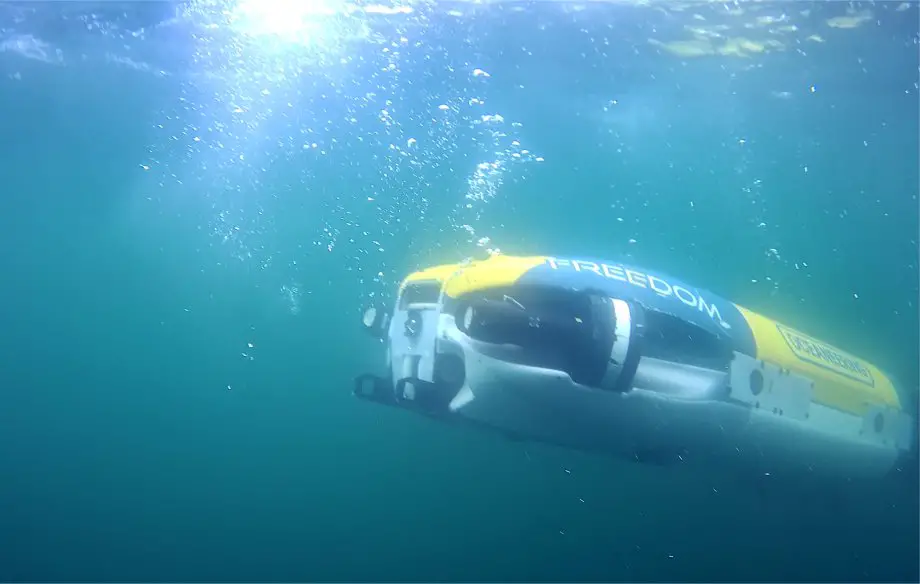Breaking news
Oceaneering selected by US Navy for its future Freedom autonomous underwater vehicle.
According to a PR published by Oceaneering on February 15, 2024, the company has announced in its Aerospace and Defense Technologies (ADTech) segment, having been chosen by the Defense Innovation Unit (DIU) to lead the development and testing of the Freedom™ Autonomous Underwater Vehicle (AUV).
Follow Navy Recognition on Google News at this link
 Freedom Autonomous Underwater Vehicle. (Picture source: Oceaneering)
Freedom Autonomous Underwater Vehicle. (Picture source: Oceaneering)
The awarded contract encompasses a comprehensive Manufacturing Readiness Review aimed at evaluating and enhancing current production capacities to expedite the integration of LDUUV technologies within naval operations.
Following a five-year test and development trajectory, the Freedom™ AUV has transitioned into commercial operations as of 2023. Its innovative design features, including a versatile multi-thruster system that enables unparalleled maneuverability with six degrees of freedom and eight independent thrusters, position the Freedom™ AUV as a frontrunner for both defense and commercial applications. This design allows for precise, low-altitude maneuvers in complex and critical subsea infrastructures, ensuring mission success under the most challenging conditions.
Oceaneering leverages its extensive expertise in subsea robotic services and a comprehensive database from its Remotely Operated Vehicles (ROV) operations, which boasts over six million hours of operational data, to identify and integrate key technological components into the Freedom™ AUV.
These components, including thrusters, connectors, and batteries, are crucial for enhancing the vehicle's performance and reliability, ensuring a prolonged, maintenance-free operational lifespan conducive to sustained subsea activities.
AUVs into the US Navy
The United States Navy employs a diverse array of Autonomous Underwater Vehicles (AUVs) to enhance its operational capabilities, conducting missions ranging from reconnaissance and mine countermeasures to hydro-acoustic research.
These AUVs vary significantly in size, capabilities, and intended use, falling into categories that include man-portable, lightweight, heavyweight, and extra-large unmanned undersea vehicles (XLUUVs).
Man-Portable AUVs
Man-portable AUVs are the smallest class, typically torpedo-shaped and designed for easy deployment from small vessels. An example is the Mk 18 Mod 1 Swordfish, developed for low-visibility exploration activities, reconnaissance, mine countermeasures, and hydrographic mapping. Its endurance and speed allow it to cover significant areas, supporting missions up to a depth of 40ft.
Lightweight AUVs
Slightly larger than their man-portable counterparts, lightweight AUVs can weigh up to 500lbs. They are launched via small craft or a crane from a surface vessel. These AUVs, such as the General Dynamics Mission Systems’ Bluefin-12S, are equipped for mine countermeasure actions and can carry multiple payloads, offering a blend of endurance and adaptability for various operational requirements.
Heavyweight AUVs
Heavyweight AUVs are deployed for longer missions requiring substantial endurance. The Boeing Defense’s Echo Ranger is an example, capable of stabilizing itself autonomously to depths of up to 10,000ft and carrying payloads of up to 250kg. These AUVs offer advanced capabilities for extended range missions.
Extra-Large UUVs (XLUUVs)
XLUUVs represent the largest class, with no limit to their size and scope. The Orca, developed by Boeing and Huntington Ingalls Industries for the US Navy, is a prominent example.
It can undertake long-duration missions autonomously, with capabilities for mine countermeasures, anti-submarine warfare, and more. The Orca program involves the development of prototypes to fulfill urgent operational needs identified by the Pentagon, showcasing advanced mining capabilities.


























